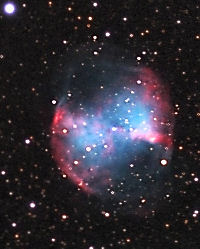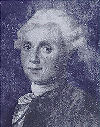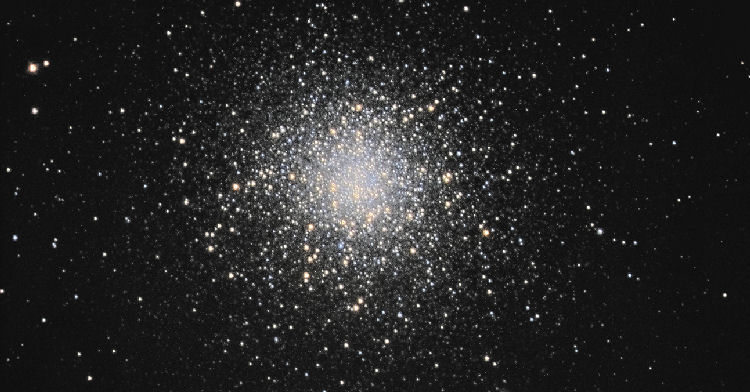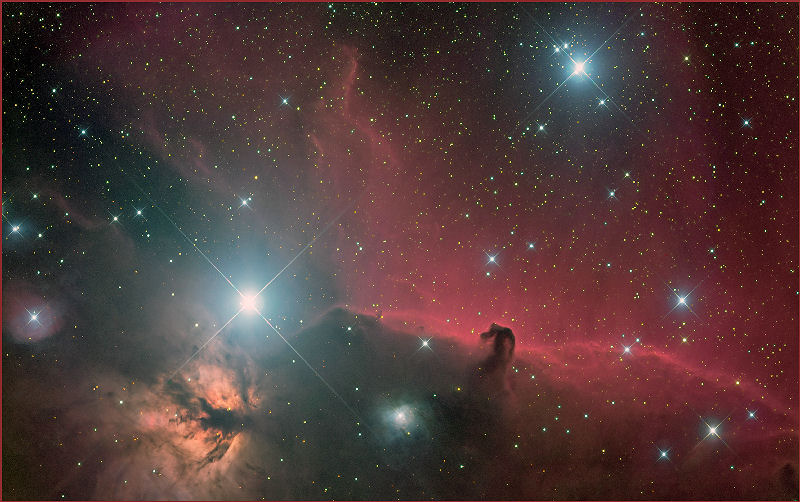The Images of Richard Yandrick Continued
of the most frustrating, and most rewarding undertakings imaginable."
— Richard Yandrick

 It was entered as the twenty-seventh object in one of astronomy's most famous catalogs — Catalogue des Nébuleuses et des Amas d'Étoiles or Catalogue of Nebulae and Star Clusters. French astronomer Charles Messier "first took these objects as uninteresting entities which were fooling him when looking for comets, the objects he was really interested in, and wanted to list them so that future observers would no more be fooled." The rest, as they say, is history! Image of Charles Messier at 40 years of age painted by Desportes in March, 1771. Credit: as seen at SEDS from a photo by Dr. Owen Gingerich. [5] At left is another of Richard's images for which he writes, "M27 is a planetary nebula in the constellation Vulpecula. It is commonly referred to as the Dumbbell Nebula due largely to the double lobed appearance through a telescope eyepiece. This image was taken through a Takahashi FSQ106 refractor with a Starlight Xpress HX916 ccd camera." Clicking on the image at left will take you to Richard's full size version of M27. It's an especially poignant image that gives one a feeling for the vastness of the cosmos and the beautiful yet solitary nature of this stellar wonder. Copyright © 2004 by Richard Yandrick.
It was entered as the twenty-seventh object in one of astronomy's most famous catalogs — Catalogue des Nébuleuses et des Amas d'Étoiles or Catalogue of Nebulae and Star Clusters. French astronomer Charles Messier "first took these objects as uninteresting entities which were fooling him when looking for comets, the objects he was really interested in, and wanted to list them so that future observers would no more be fooled." The rest, as they say, is history! Image of Charles Messier at 40 years of age painted by Desportes in March, 1771. Credit: as seen at SEDS from a photo by Dr. Owen Gingerich. [5] At left is another of Richard's images for which he writes, "M27 is a planetary nebula in the constellation Vulpecula. It is commonly referred to as the Dumbbell Nebula due largely to the double lobed appearance through a telescope eyepiece. This image was taken through a Takahashi FSQ106 refractor with a Starlight Xpress HX916 ccd camera." Clicking on the image at left will take you to Richard's full size version of M27. It's an especially poignant image that gives one a feeling for the vastness of the cosmos and the beautiful yet solitary nature of this stellar wonder. Copyright © 2004 by Richard Yandrick.M27 is a planetary nebula located at RA 19 59 36.340 and Dec +22 43 16.09. It has a radial velocity of -42 km/s and a Redshift z = -0.000140 with a listed spectral type of DA. Other names/designators include IRAS 19574+2234, Diabolo Nebula, NGC 6853 and WD 1957+225 ( from the catalogue of spectroscopically identified white dwarfs ) [6]
M13

Our next image is the type that I always take pleasure in viewing, especially when the details are fully resolved as is the case in this next image of Richard's. Illustrating what 100,000 or so stars look like up close and personal is M13 "...a famous Globular Cluster in the constellation Hercules. It lies approximately 25,100 light years from us, and is estimated to contain over 100,000 stars. Under average skies, it can be seen with the naked eye appearing as a fuzzy star. This image acquired using a Vixen Visac telescope with a Starlight Xpress HX916 ccd camera." Image copyright © 2004 by Richard Yandrick.
Also known as "The Great Hercules Cluster" this stellar object, discovered by Edmond Halley in 1714 and observed by Charles Messier in June of 1764, is one of the best example of a globular cluster visible in the Northern Hemisphere. It is also has a few of its own notable tidbits:
- The science fiction novellas "Sucker Bait" by Isaac Asimov and "Question and Answer" by Poul Anderson take place on Troas, a world within M13. In author Dan Simmon's Hyperion Cantos the Hercules cluster is where Earth was secretly moved to after it was supposedly destroyed. Source
- In 1974, an attempt was made to send a message to other worlds. A 1,679 bit message was transmitted from the 305-meter Arecibo radio observatory in Puerto Rico toward the globular star cluster M13 Source
- The four stars of the central trapezoid within Hercules are the stars epsilon Her, zeta Her, eta Her, and pi Her. Together they form the Keystone asterism where, located on the western part of the Keystone, is the globular star cluster M13. It can be viewed with the naked eye, binoculars or a small telescope [7]
The Horsehead and Flame Nebulae « Clicking here will take you to Richard's full size image. Copyright © 2009 Richard Yandrick

Our last image is, without a doubt, one of astronomy's most photographed, photogenic and photo recognized of all stellar objects outside our solar system — the Horsehead Nebula or Barnard 33. Richard's image also contains one of my favorite regions ( one of the first I ever attempted to photograph ) within this stellar area — the Flame Nebula. While the Horsehead has certainly garnered the lion's share of exposure ( no pun intended ) this stellar region actually comprises much more than the famous stellar icon which has made it so recognizable and includes: the Flame Nebula, the Horseshead Nebula, the Star Alnitak (Orion's Belt), Barnard's Loop or the Orion-Eridanus Bubble, NGC 2023 and IC 434. I highly recommend taking a moment and clicking on the link above the image as Richard's larger image is another excellent example of just what can and has been accomplished in the field of astrophotgraphy, displaying the real beauty of the hobby.
"Horsehead Nebula - Barnard 33 is the darker 'Horsehead' looking feature, with Nebula IC434 being the red glowing Hydrogen in the background. This image is a combination of Hydrogen Alpha filtered data, combined with straight Luminance and Red, Green, and Blue filtered data. Total Hydrogen Alpha was 75 Minutes, Luminance was 25 minutes, and 75 Minutes each color." — Richard Yandrick
I wish to personally thank Richard Yandrick for his time, correspondence and use of his images in this presentation of AUIT's Site of the Month web page. All of Richard's images can be viewed at his web site here www.cosmicimage.com
Glossary — for more information click on any image displayed

CCD — abbreviation for Charge Coupled Device. An IC production type technology which is essentially an image sensor employed by most digital cameras and other such devices that converts the light that strikes its surface into electrons [8]
OTA — Optical Tube Assembly is the telescope tube that contains its primary optics (whether a lens system, mirror, or both) along with a rear cell that allows adding an eyepiece and other accessories. The OTA is fastened to one of various types of mount to create an operable telescope.
Newtonian Telescope — a type of reflecting telescope invented by the British scientist Sir Isaac Newton (1643-1727), using a parabolic primary mirror and a flat diagonal secondary mirror. For more information see: Newtonian Telescope at Wikipedia — Why Choose A Newtonian Telescope — Blue Newt's Making a Newtonian Telescope
Keller Corrector — is a field of view corrector for Newtonian Telescopes. The 3-inch design is for the larger format CCD-camera which covers a larger field than previous 2" correctors. Used usually within the f-number range of f/3.5 and f/5.5.

SBIG ( Santa Barbara Instruments Group ) STL-11000 — dubbed the "golden boy" amongst astronomical CCD cameras the SBIG CCD 11000 was developed for true wide-field images in astrophotography. Capabilities are for stellar objects where other CCD equipment may require a "mosaic" type of imaging process for the same field of view. The results when using this camera are remarkable but no doubt about it — this camera requires a lot of computer muscle due to its large image format.
Sources
- APOD Website of Albiero A & B 2005 Richard Yandrick
- Simbad website information on star SADR C.D.S. - SIMBAD4 rel 1.123 - 2009.05.28CEST07:14:01
- Bohannon, John — Tooled-Up Amateurs Are Joining Forces With the Professionals New Focus publication, original download from sciencemag.org on October 11, 2007. File is .pdf format
- Simbad website information on galaxy M81 C.D.S. - SIMBAD4 rel 1.123 - 2009.06.04CEST00:18:29
- Charles Messier's Deepsky Observations from the Messier Pages at SEDS, Hartmut Frommert & Christine Kronberg, Last Modification: June 18, 2007.
- Simbad website information on planetary nebula M27 C.D.S. - SIMBAD4 rel 1.123 - 2009.06.04CEST07:03:50
- Moler, Robert C. Hercules and the Harp © 2001 by Robert C. Moler
- Mackay C. D. — Charge-Coupled Devices in Astronomy Annual Review of Astronomy and Astrophysics, Vol. 24: 255—283, Volume publication date September 1986
© Legal Copyright Notice:
Unless otherwise stated, all images are the sole copyright © property of Richard Yandrick and may not be reproduced or copied in any manner from herein without prior written permission of the owner, Richard Yandrick. The images used on the above page(s) are for the sole purpose of information and display at A Universe in Time website and have been used with the kind permission of Richard Yandrick.